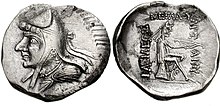Phraates I
| Phraates I 𐭐𐭓𐭇𐭕 | |
|---|---|
| Arsaces | |
 Coin of a Parthian ruler, possibly Phraates I. Minted at Hecatompylos between 185–132 BC | |
| King of the Arsacid dynasty | |
| Reign | 170/168–165/64 BC |
| Predecessor | Priapatius or Arsaces IV |
| Successor | Mithridates I |
| Died | 165/64 BC |
| Dynasty | Arsacid dynasty |
| Father | Priapatius |
| Religion | Zoroastrianism |
Phraates I (
Name
Phraátēs (Φραάτης) is the
Background
Phraates was the eldest son of the
Reign
At the start of 165 BC, Phraates attacked the powerful
Phraates' western expansion was a transgression of the traditional
Phraates notably appointed his brother Mithridates as his successor. It was common amongst Central Asian nomads for a ruler to be succeeded by his brother instead of his son. This practice may have survived amongst the Arsacids, owing to their nomadic origins.[9] A passage by the 2nd-century Roman historian Justin suggests that Priapatius had chosen Mithridates as the successor of Phraates. Olbrycht supports this theory, stating that Phraates was by himself not in a position to choose his brother over his sons, due to his short reign.[12] Justin reports that the interests of the country was of higher importance to Phraates I than that of his sons, which indicates that he supported the decision made by his father regarding the succession.[9] Phraates I died in 165 or 164 BC, and was succeeded by Mithridates I.[16][17][5]
Coinage
The coins minted under Phraates were identical to that of his predecessors. The obverse depicts the Arsacid monarch, who is beardless, and wearing a soft cap, known as the kyrbasia, which had also been worn by Achaemenid satraps.[18][19] On the reverse, there is a seated archer, dressed in an Iranian riding costume.[20][21]
References
- ^ Schmitt 2005.
- ^ Kia 2016, p. 160.
- ^ Olbrycht 2021, p. 223.
- ^ a b Overtoom 2020, p. 153.
- ^ a b Ellerbrock 2021, p. 28.
- ^ Olbrycht 2021, p. 223 (see note 87).
- ^ Overtoom 2020, p. 129.
- ^ Overtoom 2020, pp. 146, 152.
- ^ a b c d Olbrycht 2021, p. 224.
- ^ a b Overtoom 2020, p. 160.
- ^ a b Olbrycht 2021, p. 225.
- ^ a b Olbrycht 2021, pp. 224–225.
- ^ a b Brunner 1983, p. 766.
- ^ Minorsky, Bosworth & Vasmer 1991, p. 935.
- ^ Overtoom 2020, pp. 159–160.
- ^ Overtoom 2020, p. 154.
- ^ Olbrycht 2021, p. 233.
- ^ Rezakhani 2013, pp. 767, 769.
- ^ Strootman 2017, pp. 187–188 (see also note 50).
- ^ Sinisi 2012, p. 280.
- ^ Curtis 2012, p. 68.
Sources
- Brunner, Christopher (1983). "Geographical and Administrative divisions: Settlements and Economy". In ISBN 0-521-24693-8.
- Curtis, Vesta Sarkhosh (2012). "Parthian coins: Kingship and Divine Glory". The Parthian Empire and its Religions. pp. 67–83. ISBN 978-3-940598-13-4.
- Ellerbrock, Uwe (2021). The Parthians: The Forgotten Empire. Oxford: Routledge. ISBN 978-0-367-48190-2.
- ISBN 978-90-04-08112-3.
- Olbrycht, Marek Jan (2021). Early Arsakid Parthia (ca. 250-165 B.C.). Brill. ISBN 978-90-04-46075-1.
- Overtoom, Nikolaus Leo (2020). Reign of Arrows: The Rise of the Parthian Empire in the Hellenistic Middle East. Oxford: Oxford University Press. ISBN 978-0-19-088832-9.
- ISBN 978-1-61069-391-2.
- ISBN 978-0-19-973330-9.
- Strootman, Rolf (2017). "Imperial Persianism: Seleukids, Arsakids and Fratarakā". In Strootman, Rolf; Versluys, Miguel John (eds.). Persianism in Antiquity. Franz Steiner Verlag. pp. 177–201. ISBN 978-3-515-11382-3.
- Schmitt, Rüdiger (2005). "Personal Names, Iranian iv. Parthian Period". In Yarshater, Ehsan (ed.). Encyclopædia Iranica, Online Edition. Encyclopædia Iranica Foundation.
- Sinisi, Fabrizio (2012). "The Coinage of the Parthians". In ISBN 978-0-19-530574-6.
